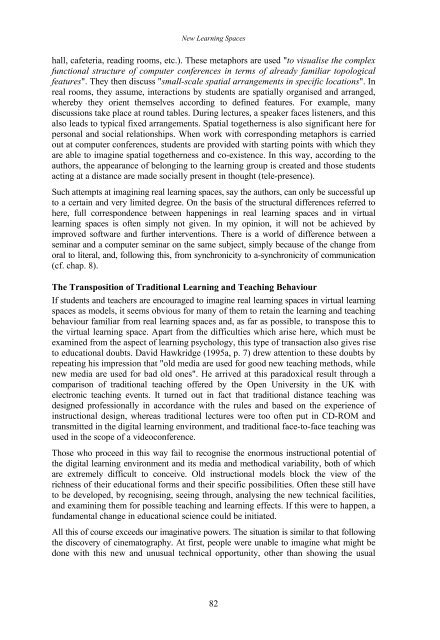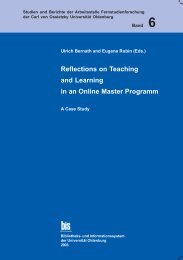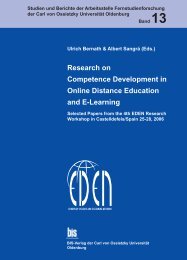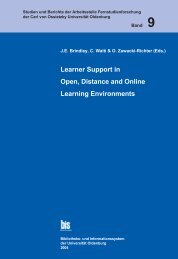Distance Education in Transition - Master of Distance Education ...
Distance Education in Transition - Master of Distance Education ...
Distance Education in Transition - Master of Distance Education ...
You also want an ePaper? Increase the reach of your titles
YUMPU automatically turns print PDFs into web optimized ePapers that Google loves.
New Learn<strong>in</strong>g Spaces<br />
hall, cafeteria, read<strong>in</strong>g rooms, etc.). These metaphors are used "to visualise the complex<br />
functional structure <strong>of</strong> computer conferences <strong>in</strong> terms <strong>of</strong> already familiar topological<br />
features". They then discuss "small-scale spatial arrangements <strong>in</strong> specific locations". In<br />
real rooms, they assume, <strong>in</strong>teractions by students are spatially organised and arranged,<br />
whereby they orient themselves accord<strong>in</strong>g to def<strong>in</strong>ed features. For example, many<br />
discussions take place at round tables. Dur<strong>in</strong>g lectures, a speaker faces listeners, and this<br />
also leads to typical fixed arrangements. Spatial togetherness is also significant here for<br />
personal and social relationships. When work with correspond<strong>in</strong>g metaphors is carried<br />
out at computer conferences, students are provided with start<strong>in</strong>g po<strong>in</strong>ts with which they<br />
are able to imag<strong>in</strong>e spatial togetherness and co-existence. In this way, accord<strong>in</strong>g to the<br />
authors, the appearance <strong>of</strong> belong<strong>in</strong>g to the learn<strong>in</strong>g group is created and those students<br />
act<strong>in</strong>g at a distance are made socially present <strong>in</strong> thought (tele-presence).<br />
Such attempts at imag<strong>in</strong><strong>in</strong>g real learn<strong>in</strong>g spaces, say the authors, can only be successful up<br />
to a certa<strong>in</strong> and very limited degree. On the basis <strong>of</strong> the structural differences referred to<br />
here, full correspondence between happen<strong>in</strong>gs <strong>in</strong> real learn<strong>in</strong>g spaces and <strong>in</strong> virtual<br />
learn<strong>in</strong>g spaces is <strong>of</strong>ten simply not given. In my op<strong>in</strong>ion, it will not be achieved by<br />
improved s<strong>of</strong>tware and further <strong>in</strong>terventions. There is a world <strong>of</strong> difference between a<br />
sem<strong>in</strong>ar and a computer sem<strong>in</strong>ar on the same subject, simply because <strong>of</strong> the change from<br />
oral to literal, and, follow<strong>in</strong>g this, from synchronicity to a-synchronicity <strong>of</strong> communication<br />
(cf. chap. 8).<br />
The Transposition <strong>of</strong> Traditional Learn<strong>in</strong>g and Teach<strong>in</strong>g Behaviour<br />
If students and teachers are encouraged to imag<strong>in</strong>e real learn<strong>in</strong>g spaces <strong>in</strong> virtual learn<strong>in</strong>g<br />
spaces as models, it seems obvious for many <strong>of</strong> them to reta<strong>in</strong> the learn<strong>in</strong>g and teach<strong>in</strong>g<br />
behaviour familiar from real learn<strong>in</strong>g spaces and, as far as possible, to transpose this to<br />
the virtual learn<strong>in</strong>g space. Apart from the difficulties which arise here, which must be<br />
exam<strong>in</strong>ed from the aspect <strong>of</strong> learn<strong>in</strong>g psychology, this type <strong>of</strong> transaction also gives rise<br />
to educational doubts. David Hawkridge (1995a, p. 7) drew attention to these doubts by<br />
repeat<strong>in</strong>g his impression that "old media are used for good new teach<strong>in</strong>g methods, while<br />
new media are used for bad old ones". He arrived at this paradoxical result through a<br />
comparison <strong>of</strong> traditional teach<strong>in</strong>g <strong>of</strong>fered by the Open University <strong>in</strong> the UK with<br />
electronic teach<strong>in</strong>g events. It turned out <strong>in</strong> fact that traditional distance teach<strong>in</strong>g was<br />
designed pr<strong>of</strong>essionally <strong>in</strong> accordance with the rules and based on the experience <strong>of</strong><br />
<strong>in</strong>structional design, whereas traditional lectures were too <strong>of</strong>ten put <strong>in</strong> CD-ROM and<br />
transmitted <strong>in</strong> the digital learn<strong>in</strong>g environment, and traditional face-to-face teach<strong>in</strong>g was<br />
used <strong>in</strong> the scope <strong>of</strong> a videoconference.<br />
Those who proceed <strong>in</strong> this way fail to recognise the enormous <strong>in</strong>structional potential <strong>of</strong><br />
the digital learn<strong>in</strong>g environment and its media and methodical variability, both <strong>of</strong> which<br />
are extremely difficult to conceive. Old <strong>in</strong>structional models block the view <strong>of</strong> the<br />
richness <strong>of</strong> their educational forms and their specific possibilities. Often these still have<br />
to be developed, by recognis<strong>in</strong>g, see<strong>in</strong>g through, analys<strong>in</strong>g the new technical facilities,<br />
and exam<strong>in</strong><strong>in</strong>g them for possible teach<strong>in</strong>g and learn<strong>in</strong>g effects. If this were to happen, a<br />
fundamental change <strong>in</strong> educational science could be <strong>in</strong>itiated.<br />
All this <strong>of</strong> course exceeds our imag<strong>in</strong>ative powers. The situation is similar to that follow<strong>in</strong>g<br />
the discovery <strong>of</strong> c<strong>in</strong>ematography. At first, people were unable to imag<strong>in</strong>e what might be<br />
done with this new and unusual technical opportunity, other than show<strong>in</strong>g the usual<br />
82





